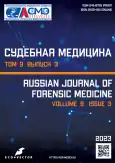Pedestrian electric-scooter fatality: A case report
- Authors: Siedin M.S.1,2, Plis S.S.1, Klevno V.A.1
-
Affiliations:
- Moscow Regional Research and Clinical Institute
- Bureau of Forensic Medical Examination
- Issue: Vol 9, No 3 (2023)
- Pages: 319-327
- Section: Case reports
- URL: https://journals.rcsi.science/2411-8729/article/view/148360
- DOI: https://doi.org/10.17816/fm7513
- ID: 148360
Cite item
Full Text
Abstract
Electric scooters are one of the most popular means of individual mobility. The active use of this two-wheeled transport on sidewalks and public roads is naturally reflected in the number of road incidents, including fatal ones. No information has been provided about the damage received by pedestrians as a result of the collision of electric scooters, and the question of the most traumatic parts of the human body with such injuries today remains to be elucidated.
This case report describes a 75-year-old patient from practice that demonstrates the mechanism, type, and nature of injury sustained at a pedestrian when an electric scooter hits him. Citizen A sustained a head injury during the fall and was hospitalized in a medical institution, where he subsequently died. During autopsy, changes were found about the exact mechanism of their formation in a scooter injury.
According to the literature, injuries associated with the collision of electric scooters mainly occur during the fall with the formation of bone fractures in the upper and lower extremities. Torso injury, according to various authors, is extremely rare, and the nature of the damage and the category of victims in these studies are generally not detailed. This case confirms the possibility of the formation of primary and secondary contact injuries in various parts of the body of a pedestrian. In addition, the case allows the possibility of identifying the means of individual mobility based on the presence of a steering wheel.
Full Text
##article.viewOnOriginalSite##About the authors
Maxim S. Siedin
Moscow Regional Research and Clinical Institute; Bureau of Forensic Medical Examination
Author for correspondence.
Email: dablV1@mail.ru
ORCID iD: 0000-0002-4724-4008
SPIN-code: 9483-6751
MD
Russian Federation, Moscow; KurskSemyon S. Plis
Moscow Regional Research and Clinical Institute
Email: SSPlis.work@gmail.com
ORCID iD: 0000-0002-0232-0425
SPIN-code: 4347-1925
Russian Federation, Moscow
Vladimir A. Klevno
Moscow Regional Research and Clinical Institute
Email: vladimir.klevno@yandex.ru
ORCID iD: 0000-0001-5693-4054
SPIN-code: 2015-6548
MD, Dr. Sci. (Med.), Professor
Russian Federation, MoscowReferences
- Bakanov KS, Lyakhov PV, Nikulin ED, et al. Road traffic accidents in the Russian Federation for 6 months of 2022. Information and analytical review. Moscow; 2022. 44 р. (In Russ).
- İğrek S, Ulusoy İ. E-scooter-related orthopedic injuries and the treatments applied. Are these a new means of transportation or a new cause of trauma? ResearchGate GmbH; 2022. doi: 10.21203/rs.3.rs-2227164/v1
- Trivedi TK, Liu C, Antonio AL, et al. Injuries associated with standing electric scooter use. JAMA Network Open. 2019;2(1):e187381. doi: 10.1001/jamanetworkopen.2018.7381
- Vasara H, Toppari L, Harjola VP, et al. Characteristics and costs of electric scooter injuries in Helsinki: A retrospective cohort study. Scand J Trauma Res Emerg Med. 2022;30(1):57. doi: 10.1186/s13049-022-01042-0
- Tan AL, Nadkarni N, Wong TH; Trauma Coordinators and Trauma Service Representatives. The price of personal mobility: Burden of injury and mortality from personal mobility devices in Singapore: A nationwide cohort study. BMC Public Health. 2019;19(1):880. doi: 10.1186/s12889-019-7210-6
- Blomberg SN, Rosenkrantz OC, Lippert F, Christensen HC. Injury from electric scooters in Copenhagen: A retrospective cohort study. BMJ Open. 2019;9(12):e033988. doi: 10.1136/bmjopen-2019-033988
- Moftakhar T, Wanzel M, Vojcsik A. Incidence and severity of electric scooter related injuries after introduction of an urban rental programme in Vienna: A retrospective multicentre study. Arch Orthop Trauma Sur. 2021;141(7):1207–1213. doi: 10.1007/s00402-020-03589-y
- Bauer F, Riley JD. Lewandowski K, et al. Traumatic injuries associated with standing motorized scooters. JAMA Network Open. 2020;3(3):e201925. doi: 10.1001/jamanetworkopen.2020.1925
- Schlaff CD, Sack KD, Elliott RJ, Rosner MK. Early experience with electric scooter injuries requiring neurosurgical evaluation in district of Columbia: A case series. World Neurosur. 2019;(132):202–207. doi: 10.1016/j.wneu.2019.08.237
- Shiffler K, Mancini K, Wilson M, et al. Intoxication is a significant risk factor for severe craniomaxillofacial injuries in standing electric scooter accidents. J Oral Maxillofac Sur. 2021;79(5):1084–1090. doi: 10.1016/j.joms.2020.09.026
- Trivedi B, Kesterke MJ, Bhattacharjee R, et al. Craniofacial injuries seen with the introduction of bicycle-share electric scooters in an urban setting. J Oral Maxillofacial Sur. 2019;77(11):2292–2297. doi: 10.1016/j.joms.2019.07.014
- Yarmohammadi A, Baxter SL, Ediriwickrema LS, et al. Characterization of facial trauma associated with standing electric scooter injuries. Ophthalmology. 2020;127(7):988–990. doi: 10.1016/j.ophtha.2020.02.007
- Yahya BH, Demetriou H, Zelnik A, et al. Trends in the Incidence and severity of injuries sustained by riders of electric bikes and powered scooters: A retrospective cross-sectional study. Medicina. 2022;58(7):934. doi: 10.3390/medicina58070934
- Singh P, Jami M, Geller J, et al. The impact of e-scooter injuries: A systematic review of 34 studies. Bone Joint Open. 2022;3(9):674–683. doi: 10.1302/2633-1462.39.BJO-2022-0096.R1
- Sheikh M, Islam A, Kroeker N. Electric scooter related injuries in Calgary emergency departments. Can J Emergency Med. 2022;24(7):735–741. doi: 10.1007/s43678-022-00378-x
- Tagaev NN. Forensic damage assessment to establish the mechanisms of fatal motorcycle injury [dissertation abstract]. Kiev; 1982. 20 p. (In Russ).
- Uluk D, Lindner T, Dahne M, et al. E-scooter incidents in Berlin: An evaluation of risk factors and injury patterns. Emergency Med J. 2022;39(4):295–300. doi: 10.1136/emermed-2020-210268
- Aulino G, Polacco M, Fattoruso V, Cittadini F. A cranio-encephalic trauma due to electric-scooter accident: Could the wearing of a helmet reduce this risk? Forensic Sci Medi Pathol. 2022;18(3):264–268. doi: 10.1007/s12024-022-00477-2
- Donchenko VV, Kupavtsev VA. Analysis of the main classification systems of means of individual mobility. Bulletin Siberian State Automobile Road University. 2021;18(3):252–263. (In Russ). doi: 10.26518/2071-7296-2021-18-3-252-263
Supplementary files









